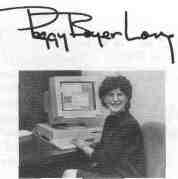|
EDITOR'S NOTEBOOK

Illinois Issues documents the
way we were, the way we are
by Peggy Boyer Long
Inflation, unemployment and the
price of gas were up. Confidence in
government was down. Yet a handful of
optimists persisted in publishing the first
issue of a 32-page monthly, bearing on
its logo the brave slogan, "The magazine
that makes public business your
business." That was January 1975.
Even then, the slogan seemed a bit
earnest, the design conspicuously austere.
And the timing inauspicious.
After all, the momentous events of our
public life appeared to be past tense.
Former Gov. Otto Kerner was in prison.
The summer before, Richard Nixon
waved goodbye to his presidency, and to
the wreckage our national politics had
become. The Vietnam War was about to
grind to a close. A chapter had ended.
What was left to add?
But what is striking in hindsight is how
much social and political change was
happening in the back half of the cynical
'70s, though in less dramatic fashion.
What is striking, too, is how much the
early editions of Illinois Issues --- how
much the editions over the past 25 years
— reflected who we were. In an introductory note on page 2 of that first issue, the
staff announced that the magazine's
writers would include "newsmen who
cover government activities."
|
Close enough. At the time, there were
about 30 reporters covering the legislature full-time, only one a woman. But
then, there were only 14 women in
the legislature. No woman had held a statewide executive
post, or a seat on the Illinois Supreme
Court.
What was commanding the attention
of those writers that first year?
Phyllis Schlafly of Alton was
attracting 5 million of the nation's
listeners to her radio program, according
to CBS, and to her message that "it is a
wonderful right that a wife be provided
with a home by her husband." She used
that message, along with the apple pies
she and her supporters delivered to lawmakers, to dash hopes for a federal Equal
Rights Amendment.
Chicagoan Cecil Partee was elected the
first black president of the state Senate.
(There was only one black reporter in the
Capitol press corps.) The battle between
Chicago Mayor Richard 1 Daley's
Democratic loyalists and supporters of
independent Democratic Gov. Dan
Walker would stretch the balloting for
House speaker into three long weeks and
93 ballots. Democrat William Redmond
of Bensenville was elected, but only after
Republicans jumped the partisan aisle. A
freshman from Elmhurst by the name of
Lee Daniels was the first to break party
ranks.
Unemployment stood at 8 percent,
twice the number of unemployed people
as one year earlier. State spending had
topped $8 billion. That was, some
worried, $138 million more than the state
was taking in. The governor instituted a
job freeze, which he said would save $15
million.
Officials looked to Illinois coal as a way
out of the energy crisis, but despite the
rising price of gas at the pump, the state's
highway program was doing fine. Meanwhile, environmentalists worried about
the byproducts of Illinois' growing
"nuclear commitment."
Ag experts advised that crops fertilized
with urban sewage were safe to consume,
"unless a continual application resulted
in a dangerous accumulation of heavy
metals." Planners, worried about sprawl,
warned that as many as 250, 000 people
could be living in McHenry County by
1990. Economists argued Chicago was
becoming a global city. (The Shah of Iran
had visited and was "fascinated" with the
way the city worked.)
And the guy who prosecuted Kerner
was running for governor.
The magazine staff dropped the slogan
--- and over the years it has updated the
design -- but it's still making public
business your business.
4 / October 1999 Illinois Issues
